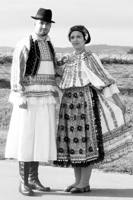
|
The Society of Folk Dance Historians (SFDH)
Choreogeography:
[
Home |
About |
Encyclopedia | CLICK AN IMAGE TO ENLARGE |

|
BACKGROUND

 Information: Few ethnic regions of Europe have contributed as much to the international folk dance repertoire as Croatia. Indeed, it is one of the most diverse of all countries in the Balkans, certainly of the former Yugoslavia, and enjoys an extremely rich folk culture as varied as its landscape. Common borders with Hungary, Slovenia, Bosnia-Herzegovina, Serbia, and Italy guarantees shared cultures with an amazing variety of folklife traditions.
Information: Few ethnic regions of Europe have contributed as much to the international folk dance repertoire as Croatia. Indeed, it is one of the most diverse of all countries in the Balkans, certainly of the former Yugoslavia, and enjoys an extremely rich folk culture as varied as its landscape. Common borders with Hungary, Slovenia, Bosnia-Herzegovina, Serbia, and Italy guarantees shared cultures with an amazing variety of folklife traditions.
Topography varies from fertile plains to deep karst valleys with rugged mountains and rocky coastline with hundreds of habitable islands and a turbulent history hundreds of years old that can and does occupy the lifelong careers of more than a few learned scholars.
As might be expected, there is music and dance in Croatia that both excites and disturbs the American aesthetic. Joyful strains of the tamburica (a family of long-necked lutes) in the north and the monotonous drone of the lijerica (a pear-shaped, three-stringed instrument which is played with a bow) in the south seem to be at opposite ends of the scale, yet they share the same serious intensity and reflect their own local cultural personality.
A look at the northern regions shows the Drmeš dominating dance traditions, an energetic, bouncy dance technique created by tensing the legs and generating the vibrations from the thigh and hamstring muscles. The resulting shivering effect accents the women's long, full skirts and frequently the men's long, loose trousers. The figures may be either danced in place or in a rapidly spinning kolo circle or with a single partner.
The northern regions where the Drmeš is found are:
Slavonia and Baranya lie on the eastern border with Hungary and have the good fortune to have the most fertile soil in the country; it is the wealthiest of all regions. The homemade embroidery of most folk cultures is not seen here. Rather, the folk regalia is decorated with elaborate designs in real gold and silver thread or elaborate cutwork embroidery, all created by professionals. Boots are not unusual here and in years past, many Slavonians served as hussars alongside their Hungarian neighbors and proudly displayed the dashing uniforms on occasions. The dance repertoire includes both kolos and couple dances and is considered to be the richest and most lively in all Croatia, including some very Hungarian-like dance forms. The kolo international folk dance known as Slavonsko Kolo is a fine example of how the dance serves as a form of social control, slyly announcing to the assembled villagers any transgressions or other gossip, ensuring strict adherence to social mores and values.
Prigorje is the region around Zagreb, a small area that maintains its unique identity in its folk dress. The Drmeš is danced in both couple and kolo formations.
Podravina lies around the river Drava along Croatia's northern border with Hungary.
Posavina is located around the river Sava that runs through central Croatia and then along the Croato-Bosnian border in southern Slavonia.
Hrvatskok Zagorje (or simply Zagorje) lies to the north of Zagreb and borders Slovenia on the north. In these northern regions, joyous singing frequently accompanies the dance. Dances are common that resemble the Polka, Waltz, and Schottisch of Slovenia and Austria, revealing the extent of the intrusion of the Renaissance influence of Europe and the limits of the intrusion of the Ottoman Empire to the east, which would have prohibited any such face-to-face dancing by members of the opposite gender.
Lika, farther south, lies at the crossroads between continental and coastal Croatia. Most roads to the sea from Zagreb pass through Lika. The rugged karst landscape provides poor soil and Lika is one of the poorer regions, depending on shepherding and logging for its livelihood. Dances here reflect a less carefree character; the Drmeš is largely missing, replaced by heavy footwork, frequently creating stamping rhythms without musical accompaniment. Folk dress is plain and generally lacks embellishment. The famous Plitvice Lakes National Park is located in Lika and tourism is now a major industry.
Istria, to the far northwest, meets Italy on the Istrian Peninsula. Very close to the ancient city-state of Venice, this is a rather remote and removed region of Croatia, nearly part of Italy. Folk dress, music, and dance reflect the Italian folk traditions; one hears familiar Italian songs sung in the Slavic language of Croatia. There is even a group of Istro-Romanian dialect; the date and route of their arrival in Istria is unclear. The ancient city of Pula is one of its major cities; an intact Roman coliseum still stands there.
Dalmatia extends south along the Adriatic Coast and includes most of Croatia's 1,000 islands. It stretches from the island of Rab to the Bay of Kotor in the country's very southern tip and includes colorful, ancient Dubrovnik. The many islands reflect the Venetian influence in dance, music, and dress. Many of them support their own unique character, often featuring ancient musical instruments and a study of the Dalmatian coastal islands is an adventure. Consider the ancient Moresca, sword dance of Korčula, and the reedy sounds of wooden wind instruments of Krk. Or the strange, colorful folk dress of the women of Susak: a flattening bodice and a very, very short skirt, almost like ballet tutu in stark contrast to the ankle-length skirts found elsewhere, and many layers of equally short petticoats worn over pink or blue knit tights. The coupe dances feature a soft run and spins by the women, accenting the skirt and petticoats.
Dubrovnik, almost its own city-state, maintains its unique identity, as is proper for a fortress that never fell to the Ottoman Turks. Linđo, pronounced LEEN-joh, is the popular dance here, performed by couples circling around the "lijerica" [a Croatian pear-shaped, three-stringed instrument] player and a caller; it's a sophisticated dance requiring not only endurance and strength from both partners, but close teamwork to execute the demanding spins and direction changes.
Konavie forms a small region in the very south of Croatia and stretches from the town of Cavtat to the Prevlaka peninsula near Montenegro.
Dry winds called "siroccos" coming from North Africa create a dry, desert-like climate along the coast, popular vacation spot for northern Europeans in desperate search of sun. By contrast, the inland regions beyond the coastal mountains with their continental climate from the north feature a green and lush landscape.
Of necessity, some small regions of Croatia have been omitted; many are subdivisions of larger regions; some are tucked away between them. All have their own unique identity, yet they all share in their Croatian character and richly deserve the intense research and popularity they have received.
DOCUMENTS
- Croatia, a country.
- Richard Duree, an article.
Used with permission of the author.
Printed in Folk Dance Scene, September 2013.
This page © 2018 by Ron Houston.
Please do not copy any part of this page without including this copyright notice.
Please do not copy small portions out of context.
Please do not copy large portions without permission from Ron Houston.